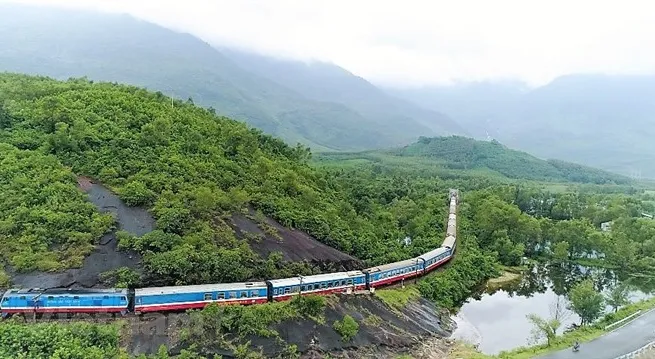Railway sector plans to improve safety, capacity with $300m
by ,http://vietnamnews.vn/society/463810/railway-sector-plans-to-improve-safety-capacity-with-300m.html15 August 2018 Last updated at 08:59 AM


|
| A section of the North-South railway. — VNA/VNS Photo Minh Sơn |
HÀ NỘI — Enhancing safety and capacity are the top priorities for the railway sector as it receives a much-needed package of VNĐ7 trillion (US$301 million) from the State budget.
Earlier in August, the National Assembly Standing Committee approved the amount, which is nearly half of the Government’s contingency fund of VNĐ15 trillion for public investment in the 2016-20 period.
The package is nowhere near the estimates of funds needed to ensure a robust revival of the flagging sector, given that the money will be used only for four critical projects along the Hà Nội – HCM City route.
VNĐ1.6 trillion ($68.6 million) was allocated for the renovation and upgrading of infrastructure on the Hà Nội-Vinh route in the north and VNĐ1.8 trillion for the Nha Trang-HCM City route in the south. The cost of upgrading degraded tunnels and important infrastructure along the Vinh-Nha Trang route, and upgrading degraded tunnels and bridge pillars of the Hà Nội-HCM City route will reach VNĐ1.8 trillion each.
The State-controlled Việt Nam Railway corporation (VNR) said that each year, it received only about VNĐ2 trillion, or 30 per cent of what it needs to carry out upkeep on 3,150km of rail lines, the majority of which are weary with age and hundreds of kilometers. Most have not enjoyed a single repair since the French colonial era.
The uneven investment throughout the cross-country rail line has reduced the overall speed of running trains to 60km/h, while the newly invested ones can reach speeds of up to 90km/h.
“The list of repair jobs just keeps getting longer, while the infrastructure keeps degrading, leading to safety risks. We had a really tough time choosing the most pressing projects to work on,” Vũ Anh Minh, Chairman of VNR, told Vietnam News Agency.
With the freshly approved budget, the railway sector expects to raise the route capacity, ensure traffic safety, enhance support infrastructure, reduce shaking on trains and improve services.
“Speed improvement is not our primary concern, but it could be improved on certain routes with upgrades. If we were to spend VNĐ10 trillion to revamp entire depot-to-depot sections of the four critical routes, then the speed gains would only save one hour of travelling – which is really not worth the amount of investment it would require,” Minh said.
“That’s why, we concentrate on the route capacity, or the number of trains passing, from 18 trains to 23-25 trains in one day,” he added.
The VNR leader also expressed concern over the need to carry out maintenance and ensure normal operation of trains on the routes at the same time.
“If things go according to plan, we could finish all four projects by the middle of 2021,” Minh said.
The VNĐ7 trillion package is part of the total budget of VNĐ110 trillion reserved for the development of existing rail lines until 2030 (excluding the planned high-speed railway). The funds were set out by the Government in 2014 but State budget constraints have delayed the final approval up until now. — VNS





